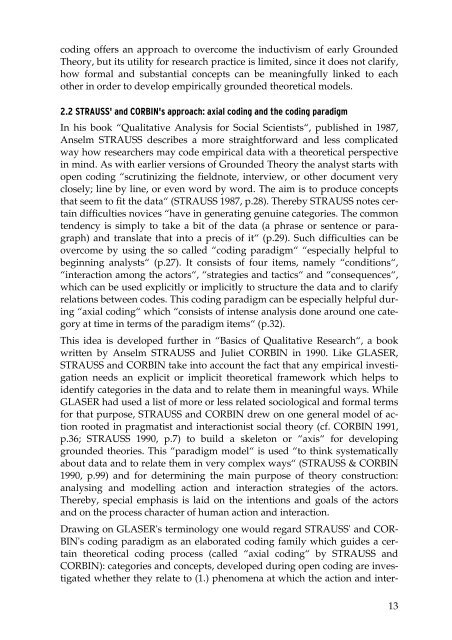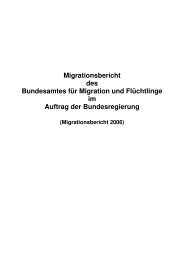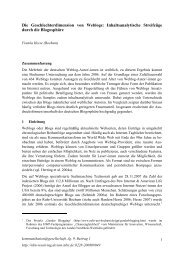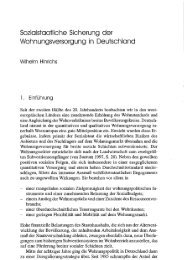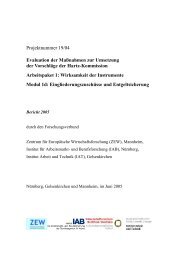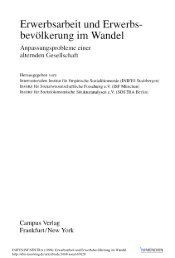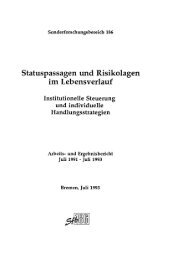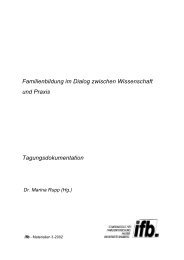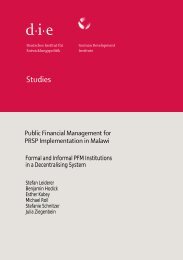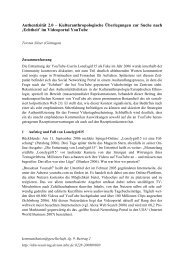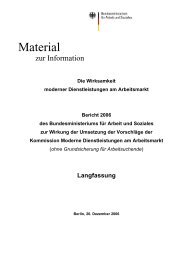Volltext - SSOAR
Volltext - SSOAR
Volltext - SSOAR
- TAGS
- volltext
- ssoar
- www.ssoar.info
Erfolgreiche ePaper selbst erstellen
Machen Sie aus Ihren PDF Publikationen ein blätterbares Flipbook mit unserer einzigartigen Google optimierten e-Paper Software.
coding offers an approach to overcome the inductivism of early Grounded<br />
Theory, but its utility for research practice is limited, since it does not clarify,<br />
how formal and substantial concepts can be meaningfully linked to each<br />
other in order to develop empirically grounded theoretical models.<br />
2.2 STRAUSS' and CORBIN's approach: axial coding and the coding paradigm<br />
In his book “Qualitative Analysis for Social Scientists“, published in 1987,<br />
Anselm STRAUSS describes a more straightforward and less complicated<br />
way how researchers may code empirical data with a theoretical perspective<br />
in mind. As with earlier versions of Grounded Theory the analyst starts with<br />
open coding “scrutinizing the fieldnote, interview, or other document very<br />
closely; line by line, or even word by word. The aim is to produce concepts<br />
that seem to fit the data“ (STRAUSS 1987, p.28). Thereby STRAUSS notes certain<br />
difficulties novices “have in generating genuine categories. The common<br />
tendency is simply to take a bit of the data (a phrase or sentence or paragraph)<br />
and translate that into a precis of it“ (p.29). Such difficulties can be<br />
overcome by using the so called “coding paradigm“ “especially helpful to<br />
beginning analysts“ (p.27). It consists of four items, namely “conditions“,<br />
“interaction among the actors“, “strategies and tactics“ and “consequences“,<br />
which can be used explicitly or implicitly to structure the data and to clarify<br />
relations between codes. This coding paradigm can be especially helpful during<br />
“axial coding“ which “consists of intense analysis done around one category<br />
at time in terms of the paradigm items“ (p.32).<br />
This idea is developed further in “Basics of Qualitative Research“, a book<br />
written by Anselm STRAUSS and Juliet CORBIN in 1990. Like GLASER,<br />
STRAUSS and CORBIN take into account the fact that any empirical investigation<br />
needs an explicit or implicit theoretical framework which helps to<br />
identify categories in the data and to relate them in meaningful ways. While<br />
GLASER had used a list of more or less related sociological and formal terms<br />
for that purpose, STRAUSS and CORBIN drew on one general model of action<br />
rooted in pragmatist and interactionist social theory (cf. CORBIN 1991,<br />
p.36; STRAUSS 1990, p.7) to build a skeleton or “axis“ for developing<br />
grounded theories. This “paradigm model“ is used “to think systematically<br />
about data and to relate them in very complex ways“ (STRAUSS & CORBIN<br />
1990, p.99) and for determining the main purpose of theory construction:<br />
analysing and modelling action and interaction strategies of the actors.<br />
Thereby, special emphasis is laid on the intentions and goals of the actors<br />
and on the process character of human action and interaction.<br />
Drawing on GLASER's terminology one would regard STRAUSS' and COR-<br />
BIN's coding paradigm as an elaborated coding family which guides a certain<br />
theoretical coding process (called “axial coding“ by STRAUSS and<br />
CORBIN): categories and concepts, developed during open coding are investigated<br />
whether they relate to (1.) phenomena at which the action and inter-<br />
13


